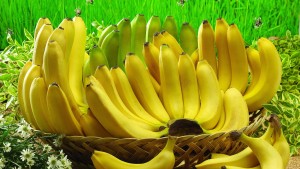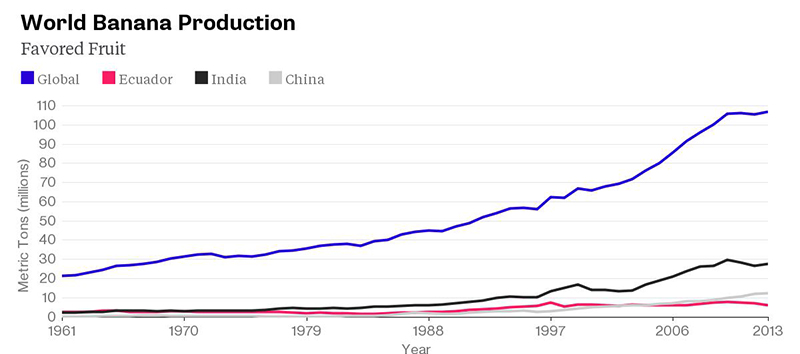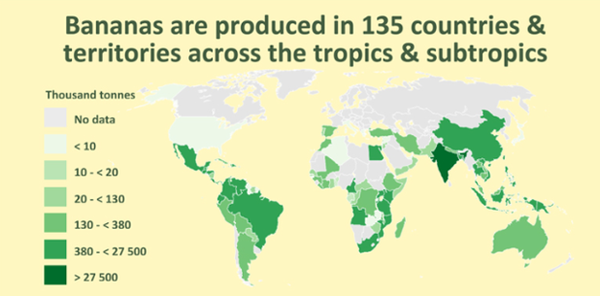Bananas
Of all the Plantations International agricultural products, the banana is the fourth most important food product within the least developed countries, being the staple food for some 400 million people. Of all the fruits, it holds first place by production volume and is among st the five most consumed fruits on the planet.
The Plantations International banana plant grows 10 to 26 feet in height and belongs to the family Musaceae. Banana fruits grow in clusters of 50 to 150, with individual fruits grouped in bunches, known as “hands,” of 10 to 25 bananas.
Bananas are the most popular fruit in the world. The banana is, in fact, not a tree but a high herb that grows up to 15 metres. It is believed that there are almost 1000 varieties of bananas in the world, subdivided in 50 groups. The most commonly known banana is the Cavendish variety, which is the one produced for export markets.
Bananas are grown in more than 150 countries, producing 105 million tonnes of fruit per year. The bananas grown for local consumption are generally grown in traditional, extensive systems. Dessert bananas account for 43 million tonnes per year and are of huge economic importance for many countries in the South. Cooking bananas (plantains and others) account for 45 million tonnes. Locally consumed bananas, which are a staple food in many tropical countries, play a major role in terms of food security.
It is believed that the earliest written reference to banana is in Sanskrit and dates back to around 500 BC. Bananas are suspected to be the first fruit in the earth by some horticulturists. Their origin is placed in Southeast Asia, in the jungles of Malaysia, Indonesia or Philippines, where many varieties of wild bananas still grow today. Africans are credited to have given the present name, since the word banana would be derived from the Arab for ‘finger’. They started to be traded internationally by the end of fourteenth century. The development of railroads and technological advances in refrigerated maritime transport subsequently enabled bananas to become the most important world traded fruit.
The Banana is one of the major and economically important fruit crop of Asian countries. Banana occupies vast area among the total area under crop cultivation in Asia region. Bananas are the fourth largest fruit crop in the entire world and most of Banana is cultivated by planting suckers. As technology development in agriculture is very fast, it results in developing tissue culture technique. Growing bananas does not require much effort but to achieve high yields or production requires dedication, farm management skills, and proper planting methods. Banana plant belongs to the family of “Musaceae” and genus of “Musa”. Bananas are indigenous to the tropical portions of India, Southeast Asia and northern Australia. Basically banana plants are not trees but giant herbs, which will reach their full height of between 10 feet and 20 feet after only a year. Every banana blossom develops into a fruit and ripe enough for consumption after about 4 to 5 months. After producing banana fruit, the plant stems die off and they will be replaced by new growth. The number of bananas produced by each plant varies based on fruit variety and other factors. Apart from being consumed as a fresh fruit, Banana leaves are used worldwide as cooking materials, plates, umbrellas, seat pads for benches, fishing lines, clothing fabric.
Health Benefits of Bananas
The following are the health benefits of Bananas.
- Bananas are good source of energy.
- Bananas are good for Heart health.
- Bananas are high in fiber, hence helps in weight management.
- Bananas help in Depression and mood swings.
- Bananas are good for bone and eye health.
- Bananas may help in preventing kidney cancer.
- Bananas are good for ulcer patients.
- Bananas are good source of vitamins and minerals
- Bananas are excellent source of potassium and B6 vitamin.
Local Names of Bananas in Asia
Banana (English), (Korean), Kera (Nepali), Kela (India), Mawz (Arabic), Saging (Filipino), Xiangjiao (Chinese), Kluai (Thai), Chu6i (Vietnamese), Kesel (Sinhalese, Sri Lanka), Chek (Combodian), Muz (Turkish),BaHaH (Russian), Kinciof (Taiwanese), Moz (Persian).
Local Names of Bananas in India
Kela (Hindi), Yethampazham (Malayalam), Vazhaipazham (Tamil), Balehannu (Kannada) Arati pandu (Telugu), Kele (Marathi), Kella (Punjabi), Kadali (Oriya), Kela (Gujarati), Lafoi (Manipuri), Khiel (Kashmiri), Kale (Bengali), Kol (Assamese), Kela (Urdu).
Major Producers of Bananas
The Banana is one of famous tasty fruit in all over the world having a great importance in other fruits due to its health benefits and uses. There are several countries which are in production of bananas. India is no.1 producer of banana in the world. Here is the list of top producers of banana.
1. India.
2. Chin
3. Uganda
4. Philippines
5. Ecuador
6. Brazil
7. Indonesia
8. Colombia
9. Cameroon
10. Tanzania
Varieties of Bananas
There are many varieties of banana grown across Asia. However, some of the popular varieties of banana are Red banana, Nyali, Safed Velchi, Basarai, Ardhapuri, Rasthali, Karpurvalli, Dwarf Cavendish, Robusta, Monthan, Poovan, Nendran, Grandnaine, Karthali, Dwarf Cavendish, Robusta, Monthan, Poovan, Nendran, Red banana, Nyali, Safed Velchi, Basarai, Ardhapuri, Rasthali, Karpurvalli, Karthali and Grandnaine, Emas, Rastali, Raja Awak, Abu, Nangka and Tanduk. Out of all these, Grandnaine is gaining popularity and may soon be the most preferred cultivar due to its tolerance to biotic stresse and good quality of bunches.
Banana Plantation Climate Requirements
Banana is basically a tropical crop, grows well in temperature range of 14°C to 38°C with RH regime of 75% to 85%.Bananas need warm climate, adequate moisture and protection from wind. Chilling injury occurs at temperatures below 12°C. The normal growth of the banana begins at 18°C, reaches optimum at 28°C, then declines and comes to a halt at 38°C. Although Bananas grow best in bright sunlight, higher temperature causes sun scorching. High velocity winds which exceed 80 km/hr damage the banana crop.
Banana Plantation Soil Requirements
Banana can be cultivated on wide range of soils. However, rich, moisture and well-drained soils with 45% clay, 70% silt, 80% loam are best for its growth. Banana plants prefer a more acidic soils with pH between 6 .5 to 7.5. Soils with low pH value make banana plants more susceptible to Panama disease. Sandy, salty, nutritionally deficient and ill-drained soil, low laying areas, black cotton soils with poor drainage should be avoided for banana farming. Supplement the soils which are deficient in nutrients with organic matter before planting the Banana trees. Banana plants require thick mulching for retaining the water and this process should be repeated as often as possible. Banana plants are very sensitive to waterlogging, because its roots will rot. This however can be resolved by planting the banana in raised beds. If you are planning for a commercial banana farming, it is advised to go for soil test.
Banana Propagation
Generally, Propagation in Banana Farming is done by suckers or tissue culture plants.
Banana Plantation Land Preparation
Growing green manuring crops like cowpea or daincha and burying it in the soil before the planting the banana is beneficial. The main field should be levelled and make weed free by give 3 to 4 ploughings and using harrow or rotavator or any suitable agriculture equipment to bring the soil to fine tilth stage. During the final plough, apply well rotten farmyard manure (FMY) as a basal dose in the soil and make sure it will be mixed well into the soil. A required pit size of 45 x 45 x 45 cm should be dug. These pits should be re-filled with topsoil along with well-decomposed farm yard manure of (FMY), 250 grams of Neem cake, and 20 grams of conbofuron. For better aeration and to prevent any soil borne diseases, these prepared pits should be exposed to sunlight for some time. This also kills any harmful insects. In case of saline or alkali soils having pH above 8.0, the pit mixture should be modified to incorporate organic matter. Adding more organic manure will reduce the salinity. Alternatively, planting can be done in furrows.
Banana Plantation Planting Material
Suckers weighing approximately 500 to1000 grams are commonly used in propagating. The best way is to start with tissue culture plantlets. Tissue culture plantlets are recommended for planting because suckers, in general, are infected with some soil-borne pathogen and nematodes. Similarly due to the variation in age and size of sucker the crop will not be uniform, harvesting of the crop will be prolonged and crop-management becomes very difficult. Hence, tissue culture plants are recommended for planting.
Advantage of Tissue Culture
The following are the advantages for going for Tissue culture plants in banana farming.
- True to the type of mother plant under well management.
- Seedlings will be free from pests and diseases.
- Can expect uniform growth of the plants and increase in crop yield.
- Early maturity of crop can be expected and maximum use of land is possible.
- With Tissue culture plants, farmers can go for round the year plantation as seedlings available throughout the year.
- Two successive ratoons are possible in a short period which will minimize the cost of cultivation.
- With this Tissue culture, no staggered harvesting.
- The productivity of the plants are high where 95% to 99% plants can bear bunches.
Banana Plantation Crop Geometry
The most economical and efficient spacing is 1.82 meters x 1.52 meter which make to fit with 3,630 plants per hectare (a wide spacing of 1.82 m between rows). The below chart shows how the plants should be planted. However, the above spacing is only possible with fertigation. Bananas can be planted with higher density at 1.5 meter x 1.5 meter but yields are poor due to competition for sunlight. The recommended distance is at 2.0 meter x 2.5 meter with 2,000 plants per hectare since that is the standard distance to minimize Sigatoka.
Banana Plantation Planting Method
Polybags should be separated from the banana plant without disturbing the root ball of the plant and then plants should be planted in the prepared pits keeping the pseudo-stem 2 cm below the ground level. Soil around the plant should be gently pressed. Deep planting of banana should be avoided.
Banana Plantation Irrigation
Generally, banana is a water loving plant and requires a large quantity of water for maximum productivity. These plants require a minimum of 2000 mm to 2500 mm annually or 25 mm per week. Deep watering should be provided during drought conditions to help leach the soil of salt.
It is common that, banana plants do not bear fruits without proper irrigation. However, do not provide over irrigation as excessive water will cause roots to rot as banana roots are poor withdrawal of water. Irrigate the plants immediately after planting in the field. Apply sufficient water and maintain field capacity. In commercial cultivation of banana, an effective way of irrigation should be identified. The best method is going for drip irrigation as it has excellent advantages over conventional irrigation. Drip irrigation controls the water to be flown and the water will effectively used at the root system and it is very use full in areas where water scarcity problem exists.
Intercultural Operations
The following are the intercultural operation should be carried out on regular basis for better growth and production.
Intercropping a Banana Plantation
The root system of banana is easily damaged by inter-cultivation hence use of intercropping is not preferred. However, short durational crops (40 to 60 days) like Green gram (mung), cowpea, and daincha are to be considered as green manuring crops. Crops from cucurbitaceous family should be avoided as these carry viruses and diseases. Intercropping is only possible during initial year.
Mulching a Banana Plantation
The benefit of using mulch is that it conserves soil moisture and keeps the soil cool as they block direct sunlight exposure. It also slows down the growth of weeds as it blocks the weeds from receiving sunlight thus minimizing labor work. The mulch should be kept at least 40 to 50 cm from the base of the plant as it generates heat when decomposing. This practice will reduce fungal diseases while improving soil texture and adding nutrients to the top soil.
Weed Control in Banana Plantations
It is essential to keep the banana plants weed free because banana plants grow in slower phase with the presence of weeds because partial of the water and nutrients are absorbed by the weeds. Five or Six manual weeding operations should be carried out. Once the banana plants reach mature stage, weed growth automatically controlled. Another best option to control weeds is to have thick mulch at the base of the plants. Mulching also helps in retaining moisture as well control the erosion in case of heavy rains. After some time mulching material will be decomposed and will work as a organic manure.
Removal of Male Banana Buds
Removal of male buds helps fruit development and increases bunch weight as well in banana farming. Male buds should be removed from the last 1 to-2 small hands with a clean cut keeping a single finger in the last hand.
Bunch Spray and Bunch Covering
Spray of monocrotophos of 0.2% after emergence of all hands takes care of the thrips. Thrips attack discolors the fruit skin and makes it unattractive. Covering bunch using dried leaves of the plant is economical and prevents the bunch from direct exposure to sunlight. Bunch cover increases the quality of fruit. But in rainy season this practice should be avoided. Sleeving of bunch should be done to protect bananas against dust, spray residue, insect and birds. For this, blue plastic sleeves are recommended. This also increases temperature around developing bunch and helps in early maturity.
Pests and Diseases
Banana plants are more prone to viral diseases, fungal diseases and insect pests. Because of this, there will be a huge impact on fruit size, quality and yield. The below given are major pest and diseases found in banana farming. For control measures of these pests and diseases, contact local department of agriculture or any agricultural university.
Propping up Bananas
Due to heavy weight of banana bunch, the plant goes out of balance and the bearing plant may lodge and production and quality can adversely be affected. Hence, they should be propped with the help of two bamboos forming a triangle by placing them against the stems on the leaning side. This also helps in uniform development of fruit bunch.
Manures and Fertilizers
Basically , Bananas crop requires nitrogen, phosphorus, potassium with a ratio of 3:1:6 and other micronutrients to ensure the plants grow vigorously. These can applied based on weather condition and plants age.
Harvesting Bananas
The banana crop will become ready for harvesting within 11 to 12 months of planting. First ratoon crop would be ready by 8 to 10 month from the harvesting of the main crop and second ratoon by 8 to 9 months after the second crop. Harvest when fingers are fairly evenly rounded. General practice is to harvest when fingers of second hand are 3/4 rounded. Alternative, for tree-ripened fruit, cut only those hands that are ripen and leave the remaining for other day. These Bananas taste the best. However, this process is time consuming and not feasible. The mother plant should be cut off after harvest as the plant can never produce again. Harvest may be delayed up to 100 to 120 days after opening of the first hand. Harvested bunch should generally be collected in well padded tray or basket and brought to the collection site. Bunches should be kept out of light after harvest, since this hastens ripening and softening.
For local consumption, 6 to 15 hands should be often left on stalks and sold to retailers or in local markets. For exporting, hands should be cut into units of 4 to 16 fingers, graded for both length and girth, and carefully placed in polylined boxes to hold different weight depending on export requirements.
Banana Plantation Yields
In banana Farming, over a period to 28 to 32 months, it is possible to harvest 3 crops i.e. one main crop and two ratoon crops. Under drip irrigation combined with Fertigation yield of banana as high as 100 tonnes per ha can be obtained with the help of tissue culture technique. The result would be similar yield in the ratoon crops, if the crop is managed well.
Post Harvesting Tasks
For export marketing, banana bunch are usually de-handed and soaked in sodium hypochlorite solution to remove the latex and should be treated with thiobendasole. Both sodium hypochlorite and thiobendasole are chemical compound or commonly known as bleach.
To find out more about how Plantations International can assist you with the development and management of your own Banana plantation and to receive a free initial consultation, please call us today on +852 5808 3775 or Click Here to contact your nearest Plantations International representative.



